I am a sucker for old stuff. Buildings, art, furniture, books, anything with a history of its own. So when I read about a new exhibit opening at the Saco Museum, I knew I’d have to see it, pronto!
Embellishments in Victorian Fashion
Sumptuous fabrics, vibrant colors and textures, masses of elaborate trims – all are defining elements of fashionable Victorian women’s clothing. Nineteenth-century designers had very definite ideas of what constituted beauty, and these concepts had a widespread impact on art and design. Embellishments in Victorian Fashion focuses on how nineteenth-century aesthetics influenced women’s clothing design and construction, and features fifty garments from five institutions in Maine and New Hampshire.
Last Saturday, sandwiched between house cleaning and my older daughter’s pre-prom photoshoot, my husband and I drove south to get a bellyful of fancy fashion. Forget that we only had an hour; I was too eager to wait!
The Saco Museum is a terrific repository of local history; we’d visited before and it’s even better now. For just $5 bucks, you can learn all about 19th century “Mill Girls,” check out a creepy Ku Klux Klan hood, see a 3-story doll house built into a fancy cabinet, and much more.
Embellishments in Victorian Fashion fills the large back room on the first floor. Entering through a short hallway lined with glass cases, the exhibit begins with relevant period pieces: old dress patterns and fashion catalogs, fabrics of the time, lace and embellishments. But the reason I came? THE DRESSES. From sumptuous to itchy, the room is chockablock with over-the-top couture. The Victorian motto? More is MORE! So layer upon layer of decoration filled their homes and (as displayed here) adorned their bodies.
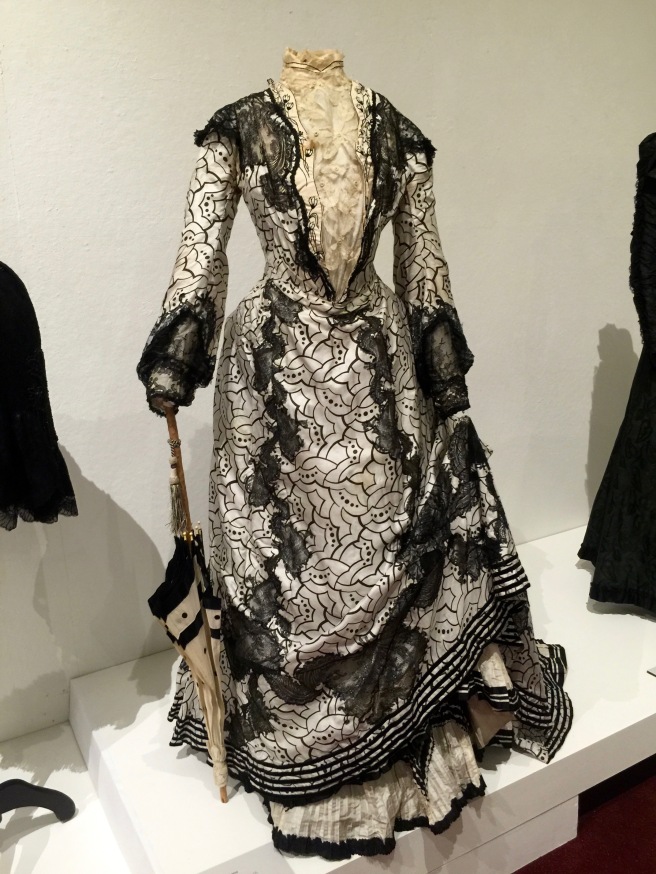
SO MANY RUFFLES. Ribbons. Cords! The Victorians gave new meaning to gussy. Even when they only had a single fabric to work with they could accomplish much with little. By folding, pleating, ruching, and creatively stitching, Victorian dressmakers could create masterpieces. Not just garments, but wearable art. And when adornments were available, like lace, buttons, beads, and more richly colored or tactile fabrics, WOW. The results were nothing short of sublime.

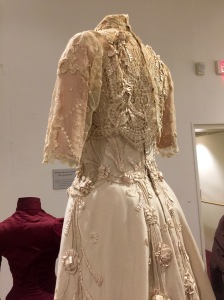
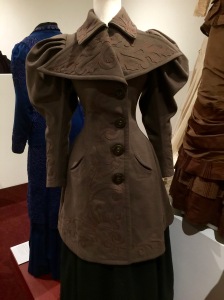

It was fascinating to see changes in the garments over time. Some subtle, others obvious. From the length and fit of sleeves and necklines, to the size of hoops and bustles, fashion transformed over the period as much as it transformed the women who wore it. What didn’t change? Victorian dresses tended to be long (often floor-length, many with elaborate trains) and waists were small. And not just small but often goddamned tiny. Some so minuscule they looked like necks. NECKS!

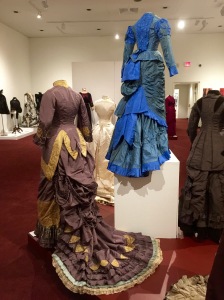
The beauty and richness of the clothing is captivating. But from a practical perspective, it pains me to think what life must have been like for the women who wore these gowns. When I worked professionally, I was forced to dress for others – to wear suits, stockings, and high heels. AND I HATED IT. It was uncomfortable and constricting, and although I knew I looked good, the minute I got home I would change. But Victorian women of a certain class, those with wealth and privilege, wore fancy dresses all the time. They weren’t getting dressed like this to scrub floors; they had others toiling on their behalf. But looking good must have been a chore. And it definitely took a toll on one’s health. Having to be cinched into a corset every day, stuffed like a sausage into a frilly casing that deforms and makes you faint? With costumes so elaborate you couldn’t even dress yourself? Oh yes, that’s my maid Martha, she laces my many layers, and fixes my hair, and promises not to steal. I mean, when I was pregnant I got so big my husband had to tie my shoes, but I put on my own pantyhose – THANK YOU VERY MUCH. These women would get dressed and then what? Play cards? Read? Sit around? If they could sit? Some of the trains on these dresses leave way too much junk in the trunk. Even if they got to eat delicious food that was prepared FOR them – it’s not like their dresses allowed them to really go HOG wild!

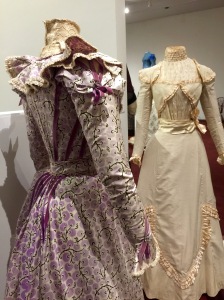
These dresses appear so delicate, graceful, and lovely, yet I imagine them as an anchor around the waists of their wearers. Heavy, awkward, and unforgiving. You basically got dressed and that was your accomplishment for the day. Being eye candy. Charming. Semi-conscious. I mean, with all the boning and cinching, you couldn’t take a deep breath, it’s no wonder women were constantly reclining on couches, being told they were helpless. Because in many ways, they were.
As an active modern woman, I take comfort completely for granted. I choose clothes as much for their style as for their feel. And if something bunches, scratches, or squeezes my meat, FORGET IT. These fabulous frocks seem so utterly impractical as to make a simple sweatsuit the best invention ever. My Victorian sisters will never know the glory of spandex, the weightlessness of nylon, the perfection of polyester blends.
I enjoyed this exhibit so much, not simply for the sheer loveliness of the clothing, but for the deeper appreciation it afforded me of my own modern wardrobe. Some may come away with a romanticized ideal of the past, longing for a return to classier times, but I myself left grateful. I walked out to *my car* in a flowy dress made of breathable rayon and airy insoles so comfortable I was skipping! And I marveled at how far women have come in just 150 years.
Viewing the fashion of my Victorian predecessors made me consider the limitations placed upon women of that time, when they were indeed slaves to fashion and female subservience was a given. As with the Americas Kitchens exhibit I saw years ago, I came away humbled. The entire experience left me wanting to hug my predecessors and kiss my yoga pants. I don’t think we really consider the extent to which modern fashion has truly liberated women. I could never, I would never, want to go back.
